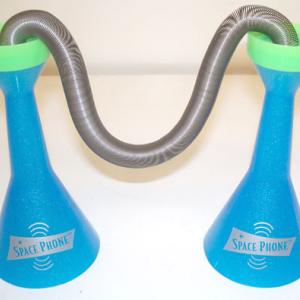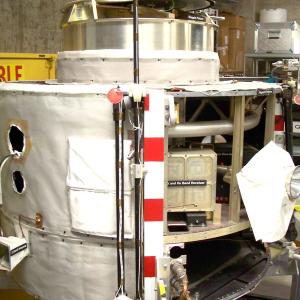College of Liberal Arts & Sciences
8A70.35 - Lightening Whistlers
See also 3B25.67 in Oscillations/Acoustics and 3B25.67 in Astronomy.
The P.D.P. was built at the U of Iowa and was used to measure plasmas around the orbiting space shuttle. While in orbit the shuttle and P.D.P. flew over a thunderstorm that was taking place on the earth's surface and 'Whistlers' were recorded. I have copies of this in my video library but there is also a copy with the video machine that is on 3rd or 5th floor (Spacecraft Engineering).
The "Space Phone" allows you to hear whistlers as the speed of sound transmission through the spring is wavelength dependant. A long Slinky can also be used for this demonstration.
- James Szeszol, Scott Welty, Theodore Ansbacher, "Mystery Physics", TPT, Vol. 27, # 3, March 1989, p. 200.
- W.R. From and J. Higbie, "Acoustic Chirps in the Snow", TPT, Vol. 21, # 9, Dec. 1983, p. 605.
- Edwin A. Karlow, "Culvert Whistlers: Harmonizing the Wave and Ray Models", AJP, Vol. 68, # 6, June 2000, p. 531.
- Frank S. Crawford, "Erratum : "Slinky Whistlers", AJP, Vol. 55, # 10, Oct. 1987, p. 952.
- Frank S. Crawford, "Slinky Whistlers", AJP, Vol. 55, # 2, Feb. 1987, p. 130.
- Stephen G. Benka, "Imaging Earth's Plasma Ducts", Physics Today, Aug. 2015, p. 23.
- "Physics Update - Simulating Whistler Turbulence", Physics Today, November 2008, p. 20.
- 6.31: Jearl Walker, "Whistlers", The Flying Circus of Physics with Answers.
- "Scientist's Space Sounds Set To Music", Associated Press, July 3, 2002.
- Tom Petruzzellis, "ELF/VLF Radio or Nature's Radio", Electronic Sensors for the Evil Genius, p. 227.
Disclaimer: These demonstrations are provided only for illustrative use by persons affiliated with The University of Iowa and only under the direction of a trained instructor or physicist. The University of Iowa is not responsible for demonstrations performed by those using their own equipment or who choose to use this reference material for their own purpose. The demonstrations included here are within the public domain and can be found in materials contained in libraries, bookstores, and through electronic sources. Performing all or any portion of any of these demonstrations, with or without revisions not depicted here entails inherent risks. These risks include, without limitation, bodily injury (and possibly death), including risks to health that may be temporary or permanent and that may exacerbate a pre-existing medical condition; and property loss or damage. Anyone performing any part of these demonstrations, even with revisions, knowingly and voluntarily assumes all risks associated with them.


